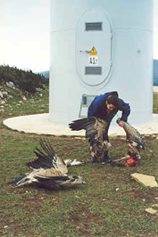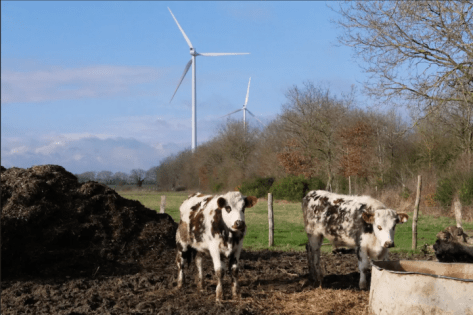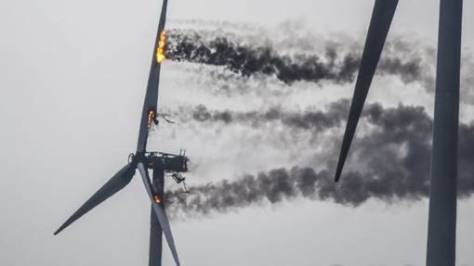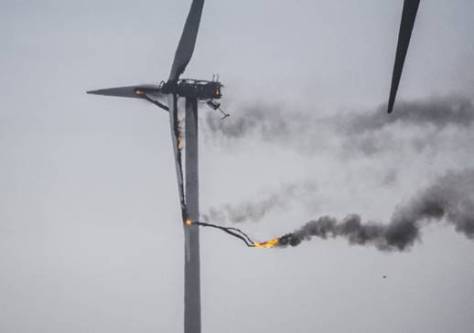 Wind industry in damage control over avian deaths and significant adverse environmental impacts of avoidance of essential ecosystems such as migration corridors. Reading spin below it begs many questions least is how do dead raptors, birds and bats killed by wind turbines “learn”?
Wind industry in damage control over avian deaths and significant adverse environmental impacts of avoidance of essential ecosystems such as migration corridors. Reading spin below it begs many questions least is how do dead raptors, birds and bats killed by wind turbines “learn”?
For a sobering reading of industry generated reports (self counted and self reported) of avian kills at wind facilities submitted to a voluntary data base please review: Bird Study Canada
Freedom of information requests made by citizens in Ontario demonstrate industry reported kill rates are much worse: Bird-Bat-Mortality-SUMMARY
Journal for the Energy Transition|March 5, 2019|

Many migrating birds have learned to avoid potentially deadly wind turbines, but this behaviour equals a loss of habitat for the animals, researcher Ana Teresa Marques and others write in the Journal of Animal Ecology. “Soaring birds are among the most affected groups with alarming fatality rates by collision with wind turbines and an escalating occupation of their migratory corridors,” the researchers write. They equipped 130 migrating black kites with tracking devices to trace their travel routes at the migratory bottleneck of the Strait of Gibraltar between Spain and Morocco — an area that is crucial for many bird species and which is also used for wind power production — and found that the animals fly about 700 metres around the turbines, effectively reducing the area available for the birds to migrate by up to 14 percent. “Authorities should recognise this further impact of wind energy production and establish new regulations that protect soaring habitat,” the researchers write.
Wind power in Germany has seen increasing resistance in recent years not least due to its possible negative effects on wildlife. Germany’s Federal Agency for Nature Conservation (BfN) recently said that more attention had to be given to the impact of renewable power development on habitats and species. “An ecologically sound renewable roll-out is possible,” BfN president Beate Jessel said. Environmental NGO Nabu estimates about 100,000 birds in the country could be killed by rotor blades each year. To put this figure into perspective: Environmental organisation Friends of the Earth Germany (BUND) says that about 18 million birds in Germany die every year by crashing into windows.
Source: Journal for the Energy Transition
Griffon Vulture hit by wind turbine in Crete (Video Duration: 5 minutes 54 seconds)
Wind turbines cause functional habitat loss for migratory soaring birds
First published: 14 February 2019Abstract
-
Wind energy production has expanded to meet climate change mitigation goals, but negative impacts of wind turbines have been reported on wildlife. Soaring birds are among the most affected groups with alarming fatality rates by collision with wind turbines and an escalating occupation of their migratory corridors. These birds have been described as changing their flight trajectories to avoid wind turbines, but this behaviour may lead to functional habitat loss, as suitable soaring areas in the proximity of wind turbines will likely be underused.
-
We modelled the displacement effect of wind turbines on black kites (Milvus migrans) tracked by GPS. We also evaluated the impact of this effect at the scale of the landscape by estimating how much suitable soaring area was lost to wind turbines.
-
We used state‐of‐the‐art tracking devices to monitor the movements of 130 black kites in an area populated by wind turbines, at the migratory bottleneck of the Strait of Gibraltar. Landscape use by birds was mapped from GPS data using dynamic Brownian bridge movement models, and generalized additive mixed modelling was used to estimate the effect of wind turbine proximity on bird use while accounting for orographic and thermal uplift availability.
-
We found that areas up to approximately 674 m away from the turbines were less used than expected given their uplift potential. Within that distance threshold, bird use decreased with the proximity to wind turbines. We estimated that the footprint of wind turbines affected 3%–14% of the areas suitable for soaring in our study area.
-
We present evidence that the impacts of wind energy industry on soaring birds are greater than previously acknowledged. In addition to the commonly reported fatalities, the avoidance of turbines by soaring birds causes habitat losses in their movement corridors. Authorities should recognize this further impact of wind energy production and establish new regulations that protect soaring habitat. We also showed that soaring habitat for birds can be modelled at a fine scale using publicly available data. Such an approach can be used to plan low‐impact placement of turbines in new wind energy developments.





 NextEra Energy is on the receiving end of a proposed class action lawsuit in which a Nebraska homeowner alleges the electricity provider’s wind turbines placed near residential communities are a “nuisance” and effectively deprive homeowners of the use and enjoyment of their property.
NextEra Energy is on the receiving end of a proposed class action lawsuit in which a Nebraska homeowner alleges the electricity provider’s wind turbines placed near residential communities are a “nuisance” and effectively deprive homeowners of the use and enjoyment of their property.